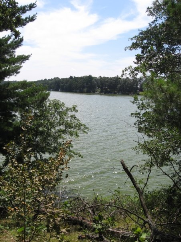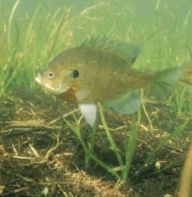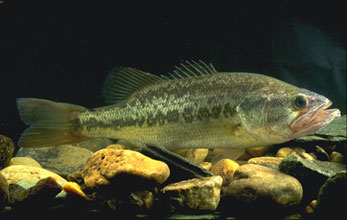Navigation
Eating, Fighting, and Fleeing: The Life of a Boxer.... and a Bluegill
BLUEGILLS ROLE IN AQUATIC FOOD WEBS
 Bluegills are abundant in waters throughout North America;
thus, they play key roles within aquatic food webs. Fry
consume aquatic invertebrates known as zooplankton. In
short, these young bluegills are secondary consumers. In
contrast, adults that consume other fish may be tertiary
consumers! Still, some act as primary consumers at times
when they feed on algae. Either way, each bluegill must
deal with intraspecific and
interspecific competition.
Bluegills are abundant in waters throughout North America;
thus, they play key roles within aquatic food webs. Fry
consume aquatic invertebrates known as zooplankton. In
short, these young bluegills are secondary consumers. In
contrast, adults that consume other fish may be tertiary
consumers! Still, some act as primary consumers at times
when they feed on algae. Either way, each bluegill must
deal with intraspecific and
interspecific competition.
| Lake Chetek in Chetek, WI- Prime Bluegill Habitat (Image taken by Author) |
INTRASPECIFIC COMPETITION
 Intraspecific competition occurs as soon as fry leave the nest. They
compete for space and nutrition on a daily basis. Once adults,
bluegills compete for space, nutrition, and the right to reproduce.
As mentioned in the reproductive section,
males display for potential female mates. Some males may even
creep into neighboring nesting sights to consume bluegill eggs as a way
of stunting competition before it occurs. Most evidence shows that
the colony of males in a particular nesting site do not partake in this
activity, however.
Intraspecific competition occurs as soon as fry leave the nest. They
compete for space and nutrition on a daily basis. Once adults,
bluegills compete for space, nutrition, and the right to reproduce.
As mentioned in the reproductive section,
males display for potential female mates. Some males may even
creep into neighboring nesting sights to consume bluegill eggs as a way
of stunting competition before it occurs. Most evidence shows that
the colony of males in a particular nesting site do not partake in this
activity, however.
INTERSPECIFIC COMPETITION
Bluegills often compete with other centrarchid
species. Centrarchids generally share nutritional and reproductive
needs. It is important to remember that an organism must get more
energy from its food than it uses to locate and ingest it. Instead
of competing, many adult bluegills travel to deeper water to fulfill
their nutritional requirements. The decrease in energy spent
searching for food outweighs the increased risk of predation.
 This
strategy often pays off. Small lakes in Michigan have up to eight
different centrarchid species. Bluegills account for 80% of the
entire fish biomass! (Spotte, 2007).
This
strategy often pays off. Small lakes in Michigan have up to eight
different centrarchid species. Bluegills account for 80% of the
entire fish biomass! (Spotte, 2007).
PREDATION IN BLUEGILLS
Bluegills are subject to predation by numerous other fish species. Immature bluegills fall prey to northern pike, largemouth bass, smallmouth bass, crappie, yellow perch, and even adult bluegills. When they reach maturity, however, they are safe from most aquatic predators because their bodies are too deep. Still, one sneaky predator uses bait, fishing poles, and boats to retrieve a healthy meal. Check out the fishing page to learn more!
PARASITIC INTERACTIONS IN BLUEGILLS
 Bluegills often act as important hosts for parasites. These
parasites gain nutrition and a safe environment from their bluegill
vector. This causes a decrease in the bluegill's growth rate, yet
most interactions are not lethal. Bluegills play host to a variety
of trematode, cestode, and nematode species. For instance, a small lake
in Barry County, Michigan had bluegills that contained 18 different
parasitic species (Pracheil, 2004).
Bluegills often act as important hosts for parasites. These
parasites gain nutrition and a safe environment from their bluegill
vector. This causes a decrease in the bluegill's growth rate, yet
most interactions are not lethal. Bluegills play host to a variety
of trematode, cestode, and nematode species. For instance, a small lake
in Barry County, Michigan had bluegills that contained 18 different
parasitic species (Pracheil, 2004).
